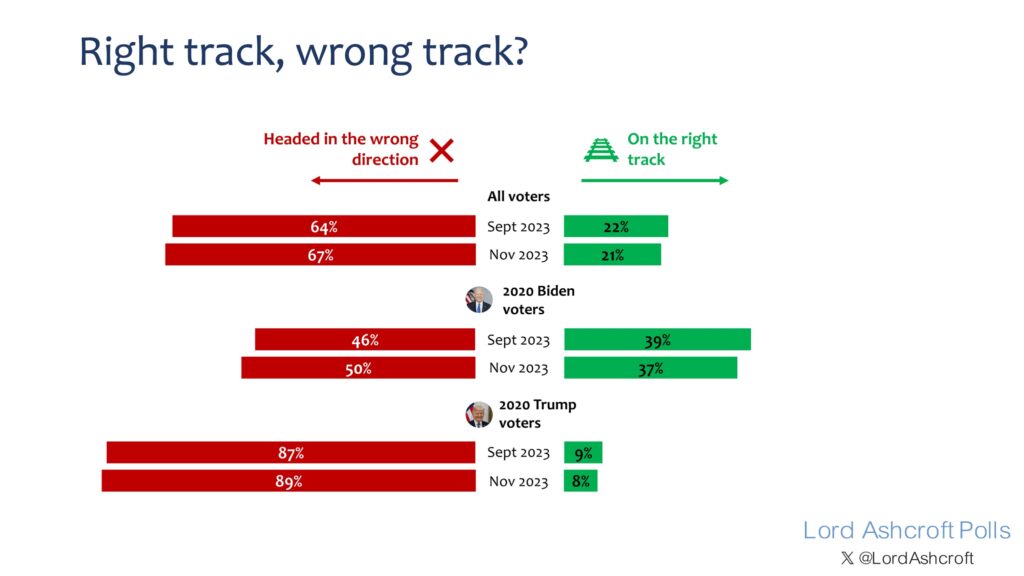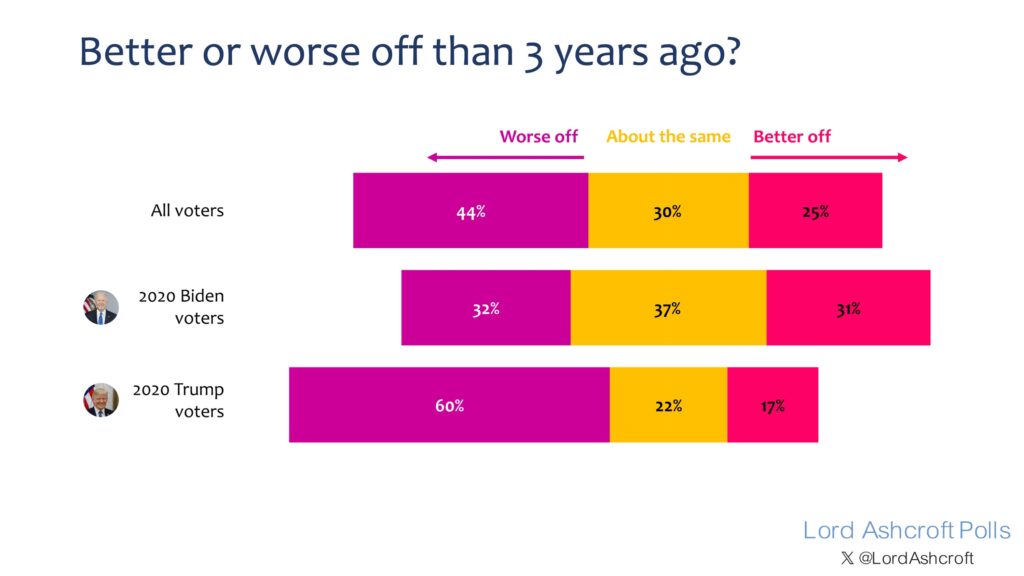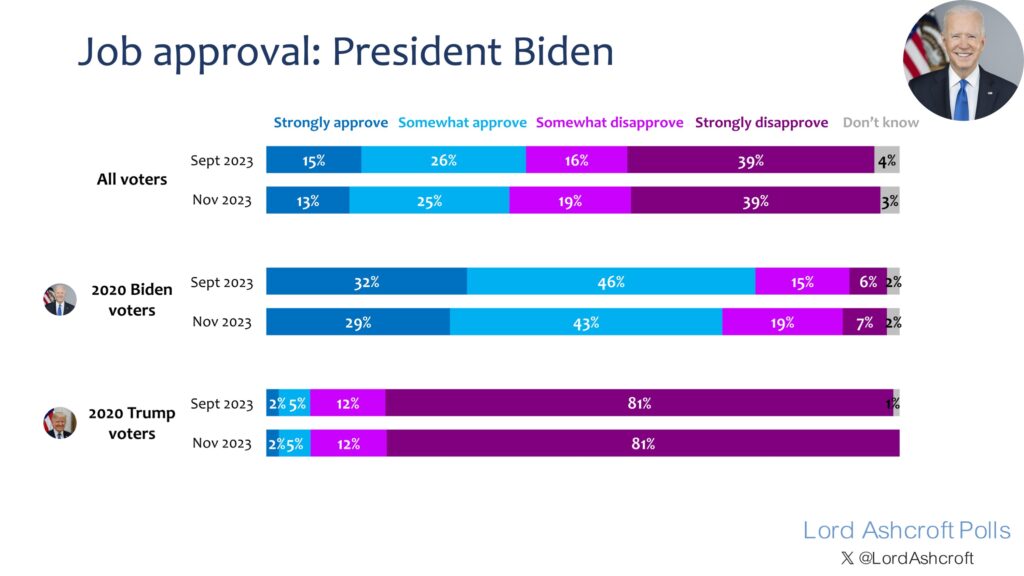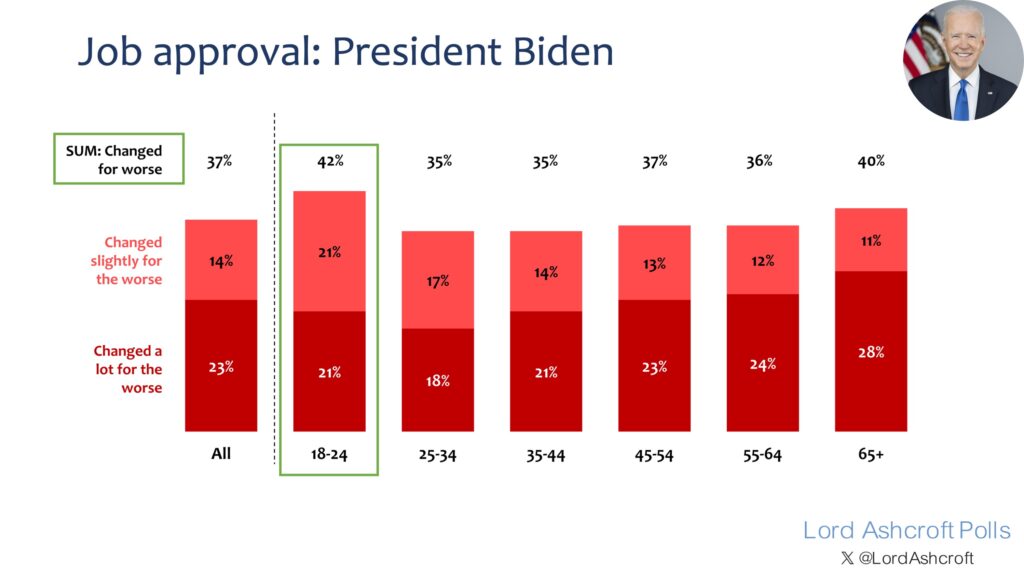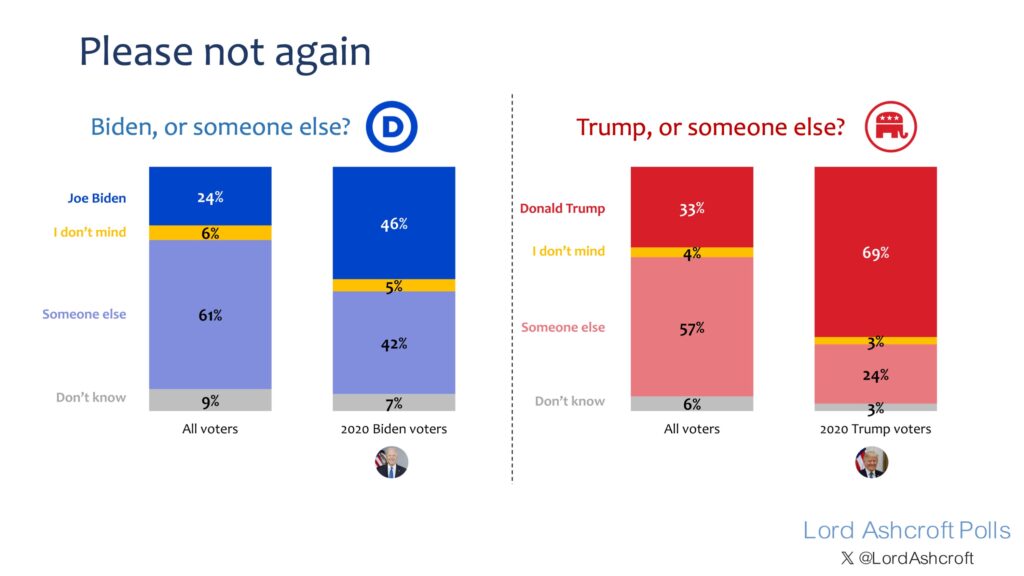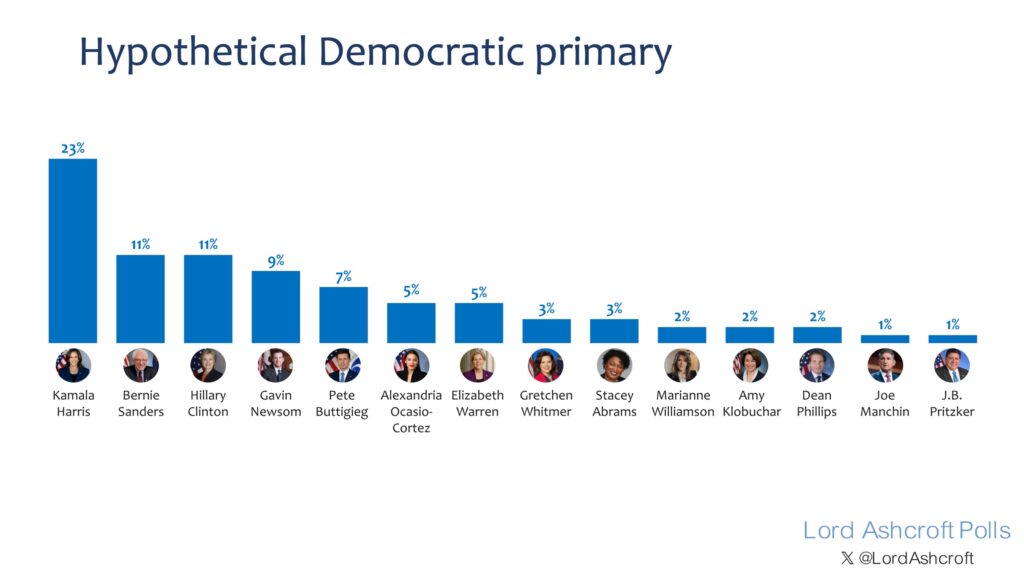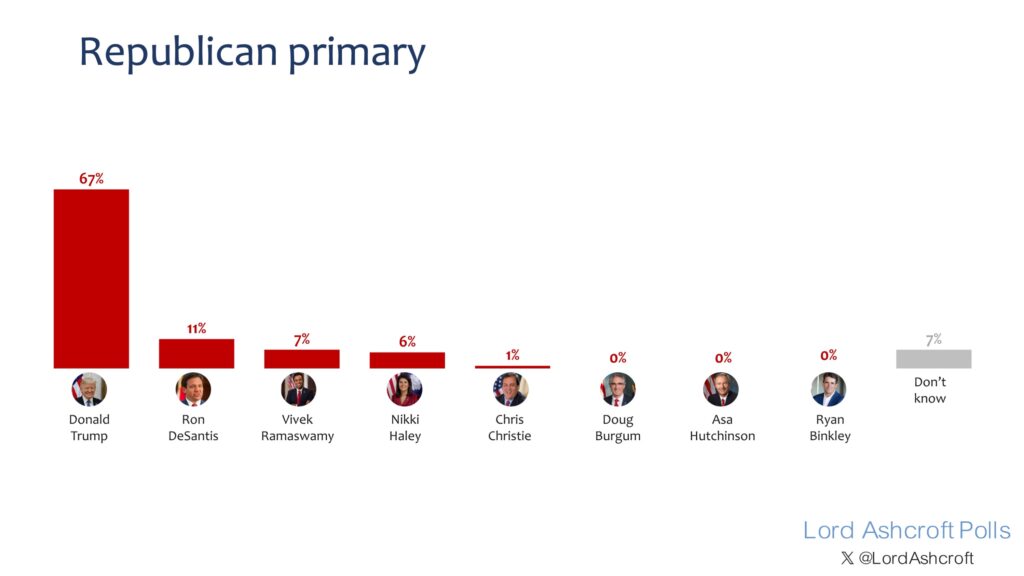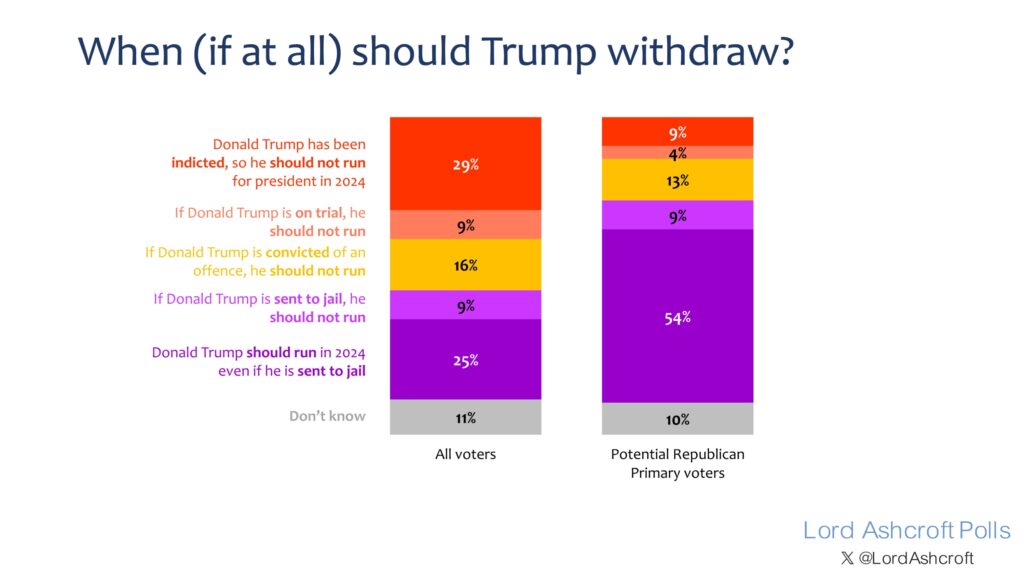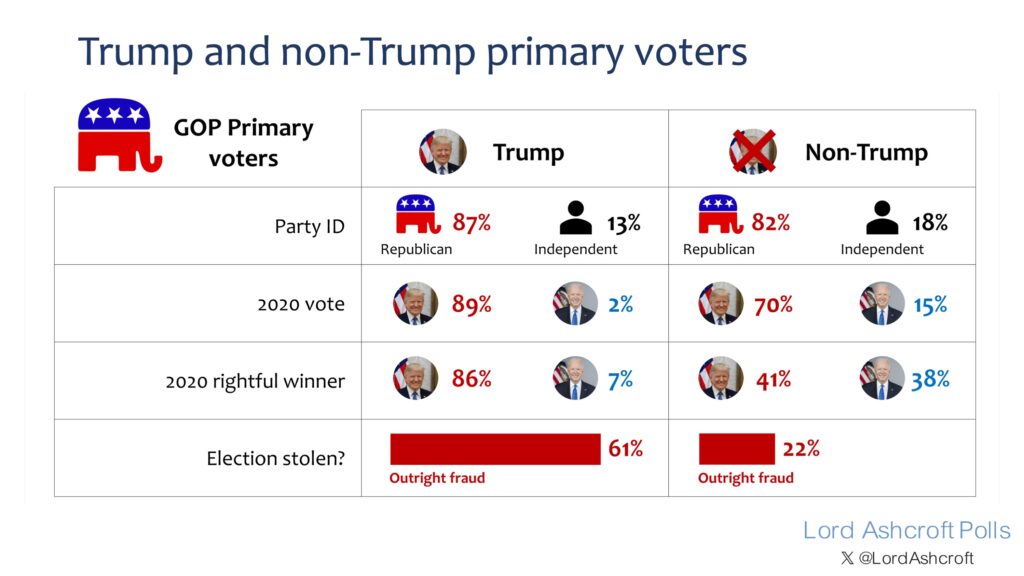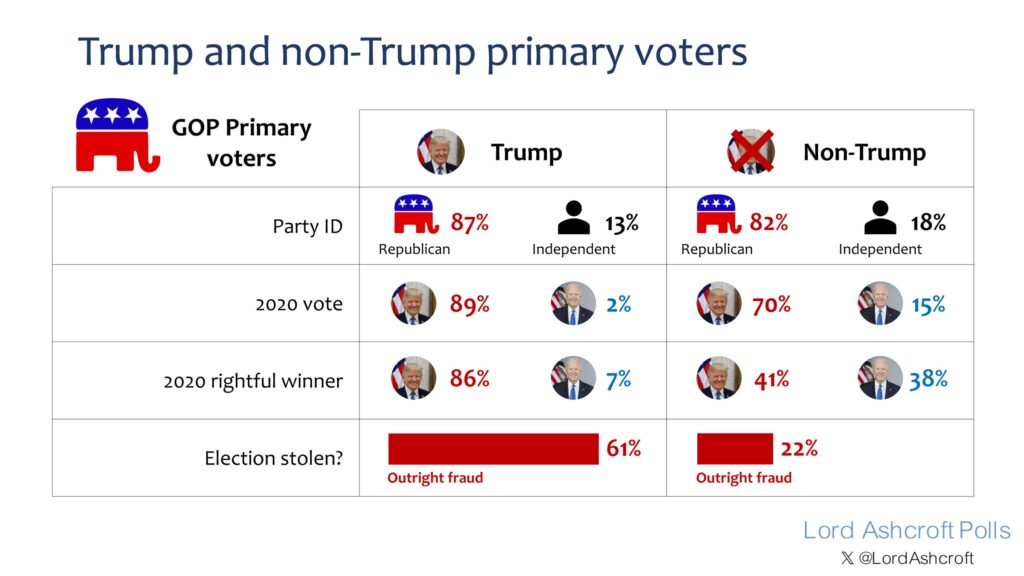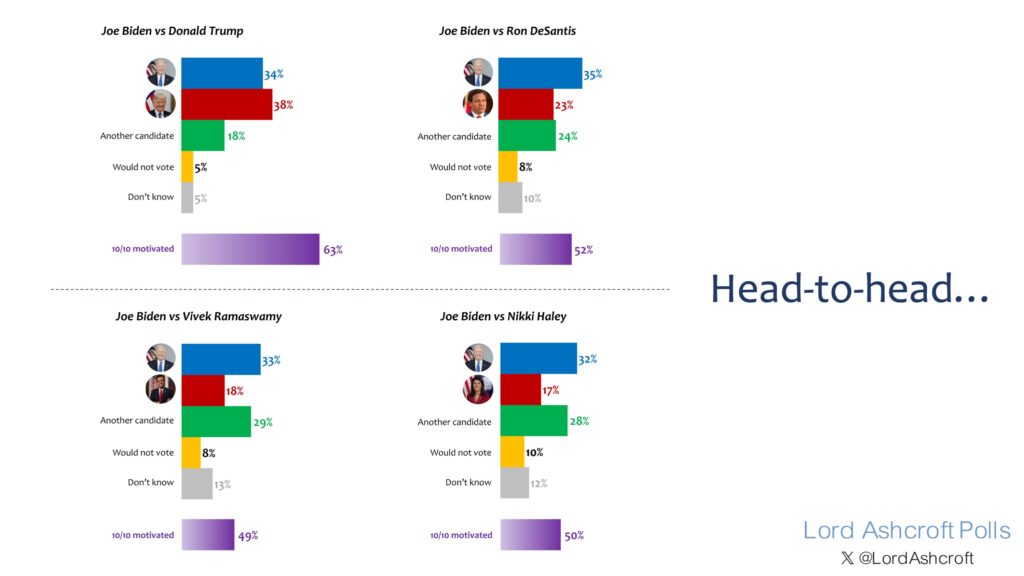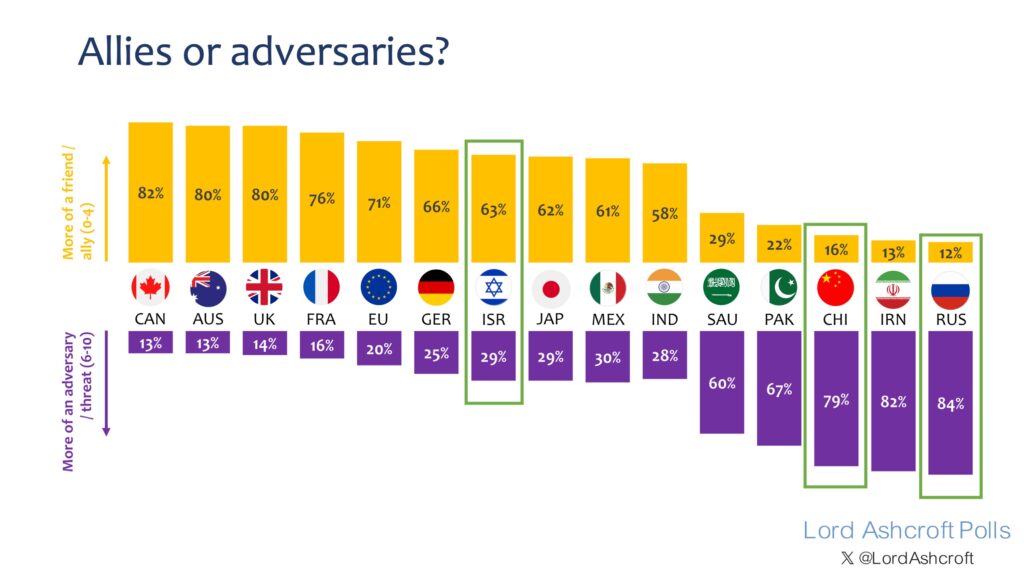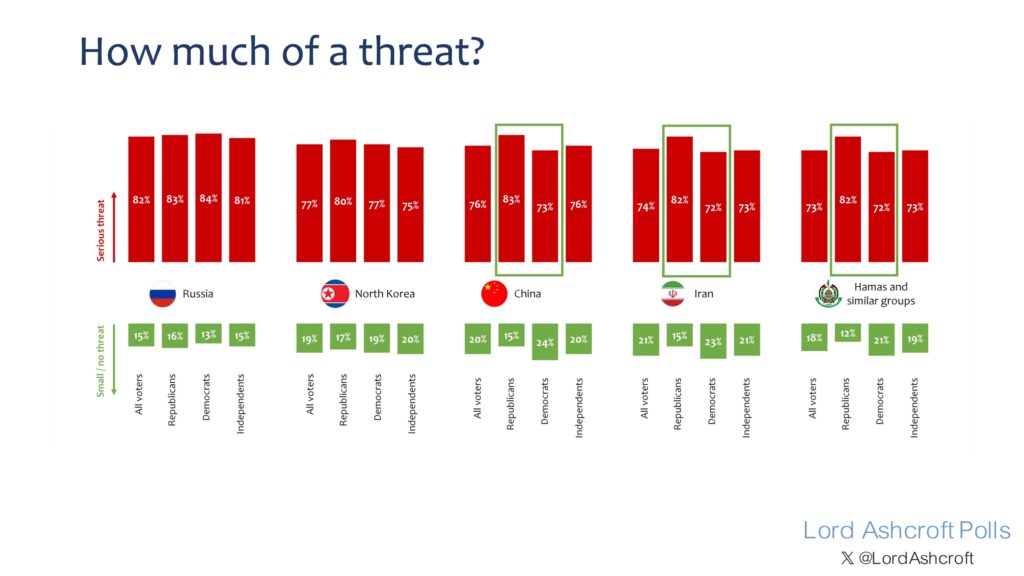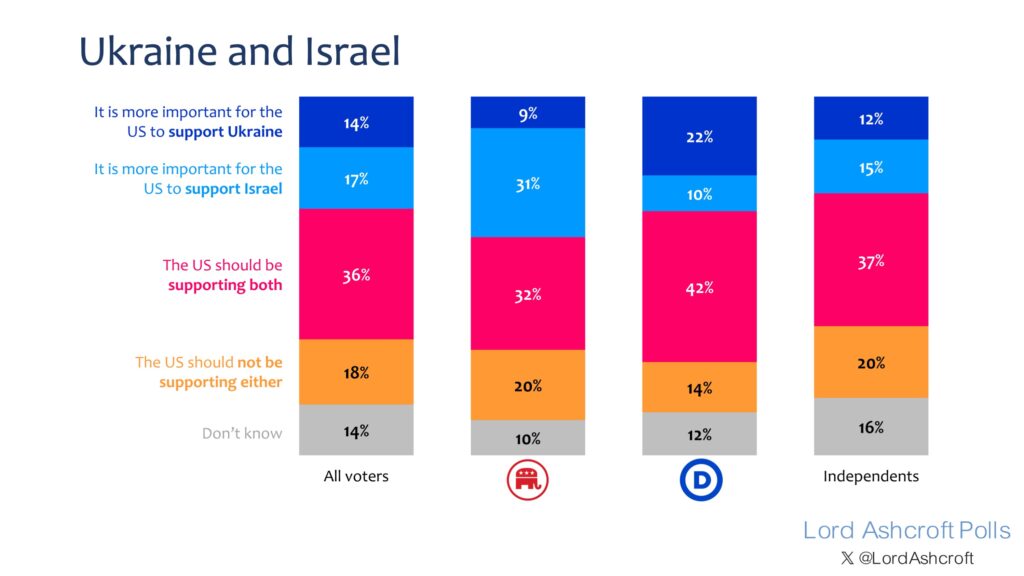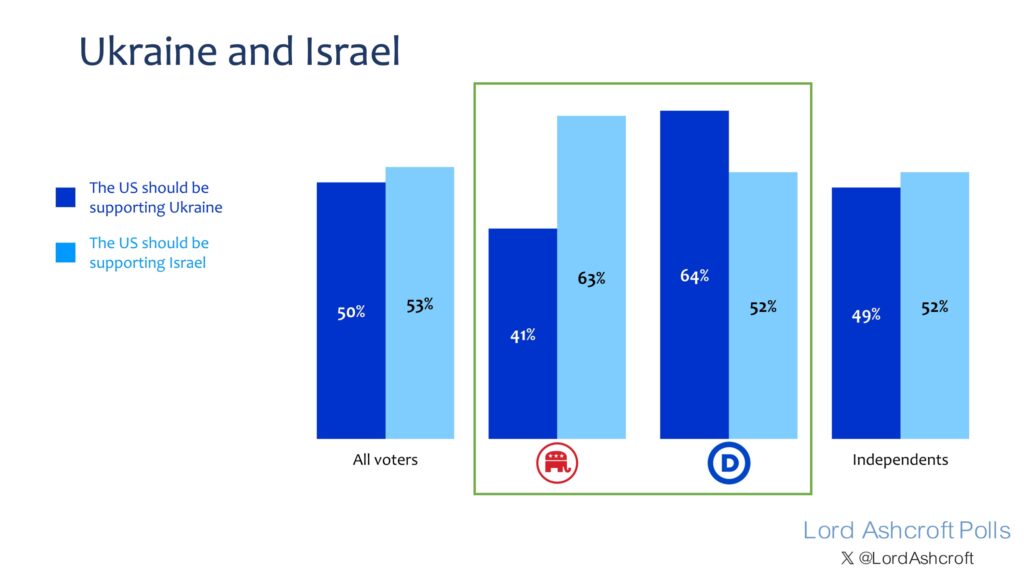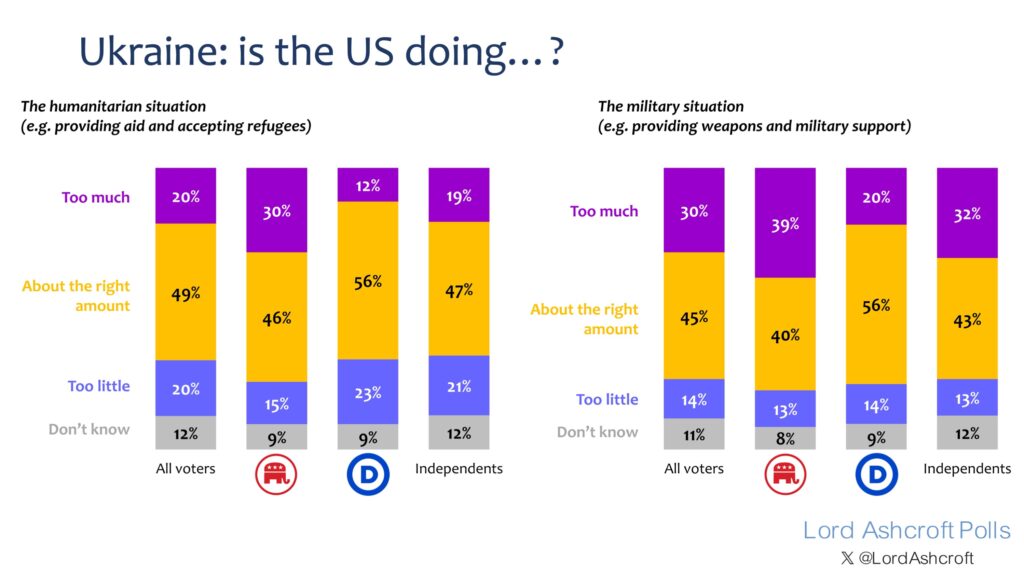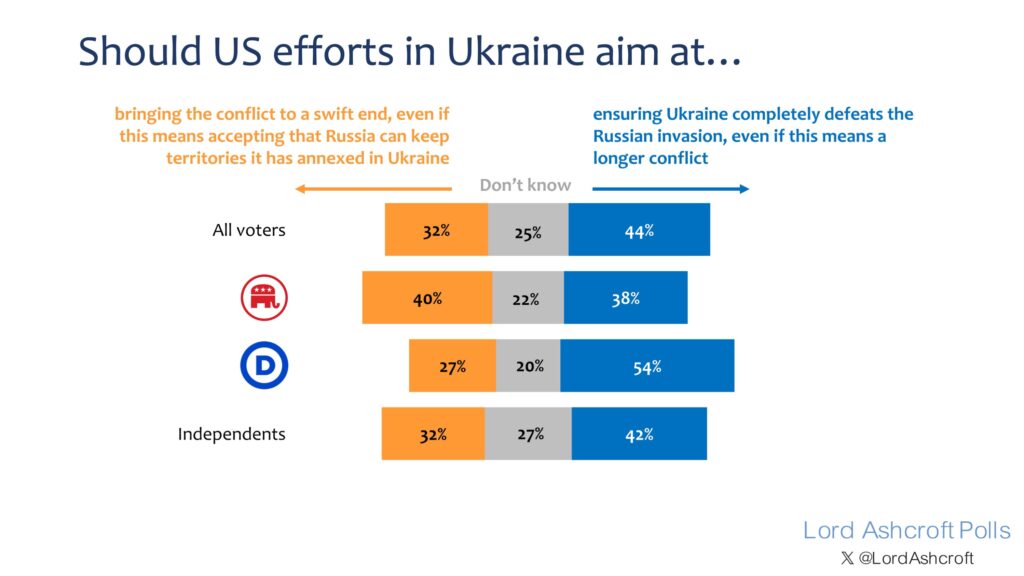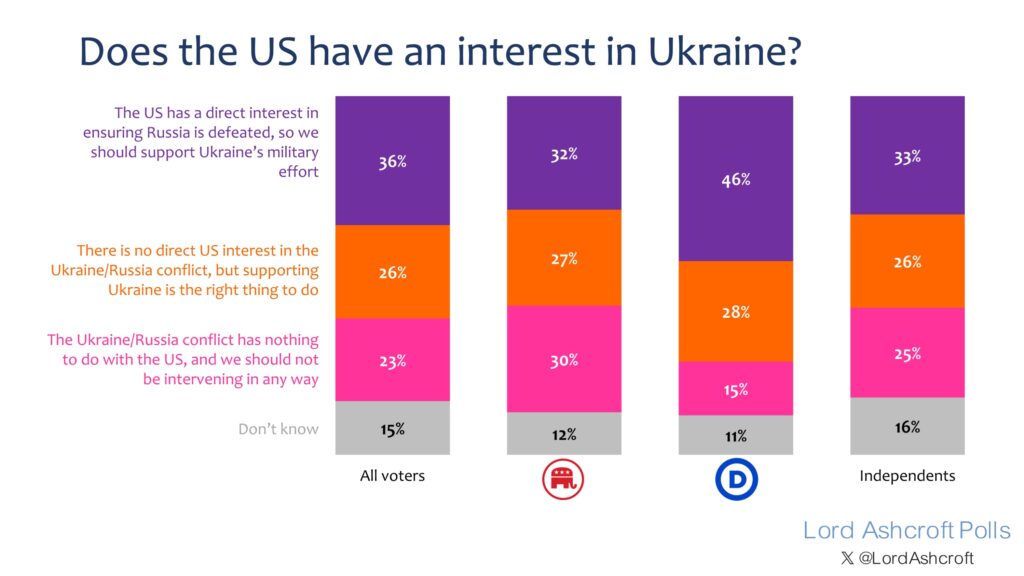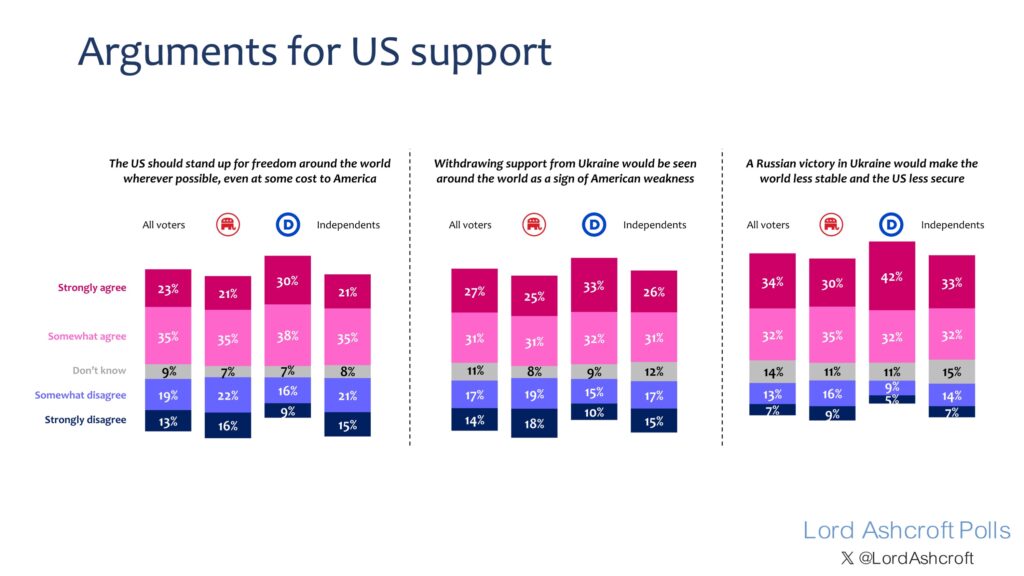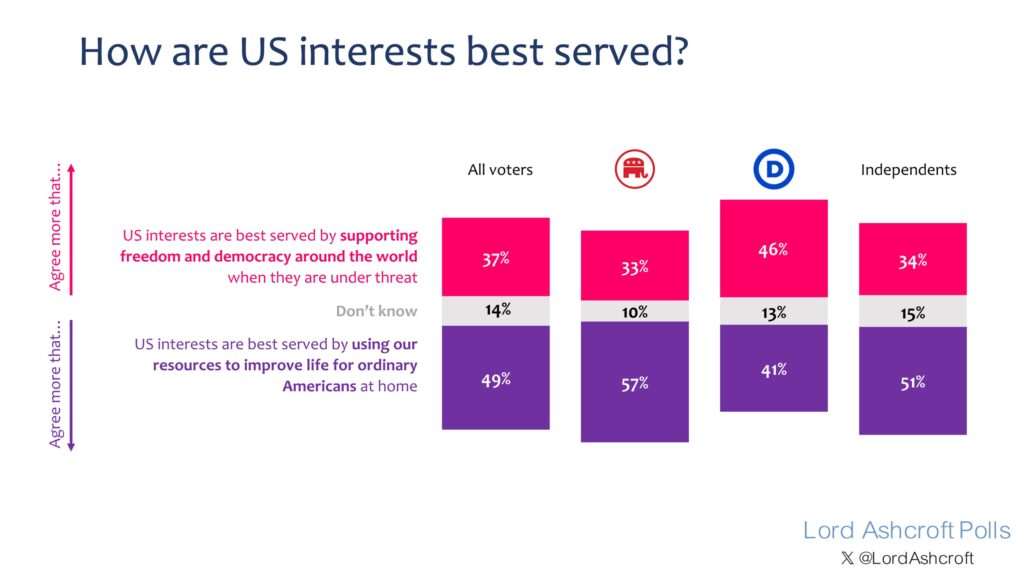
This is an edited version of my talk this week to the International Democracy Union in Washington.
Today I will talk about the findings of my latest research in the United States, focusing on two main elements. First, the evolving presidential campaign in both main parties. Second, the implications of this for an issue that matters to all of us, namely how American voters see their country’s role in the world, particularly their attitude to continuing support for Ukraine in its struggle against the Russian invasion. Most of this is drawn from a 10,000-sample poll conducted last month, with some references to an even bigger survey conducted earlier in the campaign, including focus groups in four key states.
Overall, two thirds of Americans say their country is on the wrong track. The proportion saying this has crept up since I last asked the question in September. Those who voted for President Biden in 2020 are more likely to say America is on the wrong track than the right one – indeed fully half of them say the country is heading the wrong way.
Despite some positive recent economic indicators only just over one third of voters expect the US economy to do well for the country as a whole over the next year, with a clear majority expecting things to go badly, including 4 in 10 of those who voted for Biden. When we ask how they expect things to go for themselves and their families, overall there are more optimists than pessimists. But we also found only a quarter of voters feeling better off than they were three years ago, with nearly half saying they were worse off – including one third of 2020 Biden voters.
This helps explain why I found Joe Biden’s approval rating down again since September to just 38%, with more than 1 in 4 of his 2020 voters now saying they disapprove of his performance as president. Compared to September, I found his job approval down 4 points among African Americans, down 5 points among 18 to 24s and down 8 points among Hispanic voters.
When we asked whether people’s views of the president had changed in the last few weeks, the response was striking, especially when we look at the results by age. No less than 42% of 18 to 24 year-olds said their opinion of Biden had recently changed for the worse. The explanation is almost certainly the president’s firm support of Israel since the Hamas attacks of 7th October – ironically one of the few of Biden’s positions that many in this room would applaud.
Given all this, together with increasing concern over his age and condition, it’s hardly surprising that less than a quarter of all voters say they want to see Joe Biden as the Democratic nominee in 2024. Most also want to see someone other than Donald Trump as his opponent. But while a clear majority of Trump’s former voters want to see him on the ticket, not even half of those who voted for Biden in 2020 want him to run again.
So why is the president whom most voters think is long overdue for retirement cruising to another nomination, with the support of 70% of Democratic primary voters in my poll? And why doesn’t he step down with dignity?
The answer is the turmoil that would follow from trying to find a replacement. In my survey, job approval ratings for Vice President Kamala Harris were even worse than those of her boss. The point is underlined when we ask likely Democrat primary voters whom they would back in a hypothetical contest if Biden were to retire. Harris leads the field, but with a hardly convincing 23% of the vote. The fact that Bernie Sanders and Hillary Clinton are tied for second place doesn’t exactly indicate Democrats’ confidence in their party’s eventual post-Biden future.
On the other side, I found Donald Trump’s position nationally among likely Republican primary voters strengthened since my September poll, with DeSantis a not-very-close second and Haley and Ramaswamy slugging it out for third place. The candidates will tell you with some justification that it is the race in individual states that matters, and that the campaign continues to evolve. But overall, the picture is clear: Trump remains the man to beat and it is hard to see anyone catching him unless something changes dramatically.
But with this former president, a dramatic turn of events is not something you would want to rule out. The most obvious potential trigger for such a reversal is one or more of the legal cases lined up against him. I found in my September research that most Republicans and a good number of Democrats think the lawsuits are politically motivated – though this often means that while the charges would never have been brought against a defendant not called Donald J. Trump, that doesn’t necessarily mean there is no case to answer. Likely Republican primary voters also say the indictments make them more rather than less inclined to support him, and will help rather than hinder his chances of victory.
But at what point do people say enough is enough? Fewer than one in ten primary voters say the indictments are reason enough for him not to run. A further 26% say he should withdraw if he is on trial, convicted or imprisoned during the campaign. But more than half told us he should continue to run even if he is sent to jail.
These numbers are pretty stark, but my sense from the focus groups is that even if they think the charges are political, for Trump to be convicted by a jury would prompt considerable soul searching among his potential supporters.
You sometimes hear that Trump supporters’ loyalty to their man amounts to a “cult of personality”, but I don’t think that’s quite right. Their support is a transaction, as it always was. As in 2016 and 2020, they know his flaws but see someone who will act on the things they care about – whether that’s a stronger economy, a healthy investment portfolio, a realistic energy policy, or a counter to the left’s identity politics. They also believe he will defend their values, even if he doesn’t exactly embody them.
They like that he “demands the room” in a way no other candidate they have seen yet does. When it comes to choosing an effective advocate for their interests, as one put it, “nobody does Trump as well as Trump does.” They also see him as the Republican most likely to beat the Democrats next November.
The size of our September poll enabled us to look at the differences between likely Trump and non-Trump primary voters. On most issues – priorities for government, views about ‘woke’ issues, foreign affairs, immigration, energy policy – there is little to choose between the two groups. But a few points of difference stand out.
Most striking is that fewer than half of non-Trump primary voters say that Trump was the rightful winner of the 2020 election, compared to 86% of those backing the former president. Trump voters are also nearly three times as likely as their non-Trump counterparts to say that the official result is down to outright fraud, rather than the Democrats simply benefiting from new rules on things like absentee ballots.
The two groups also diverge slightly when it comes to the kind of candidate and campaign they want to see. While most Trump supporters think the priority at the general election is to enthuse the Republican base, non-Trump voters see more of a need to appeal to independents and 2020 Biden voters.
While more than three quarters of Trump voters want a candidate who will fight for Republican policies and principles, nearly half of his challengers’ voters want a nominee willing to work with opponents and seek bipartisan solutions. And while most Trump voters stick to the idea that their man was robbed in 2020, non-Trump primary voters overwhelmingly think it’s time to accept that result and move on (though in my groups, even his supporters wanted him to shut up about the last election and concentrate on the next one). There are also some differences over foreign policy, which we will come onto later.
Polls about hypothetical nominees should be taken with an even bigger pinch of salt than other voting-intention surveys, but we asked the question in my November survey anyway. At first glance, this seems to suggest that Biden would beat any Republican other than Trump. Part of the explanation for this is shown in the purple bar under each chart, which shows the proportion of Republican primary voters who say they would feel extremely motivated to get out and vote in each contest. In the absence of Trump, as you can see, enthusiasm falls away quite quickly – with Trump still on the scene, the Republican base is not yet ready to get excited about someone else.
However, I think there is another important point from these numbers, which is the apparent ceiling on the Biden vote. He has an enthusiasm problem of his own, for the reasons we’ve seen. In none of these scenarios does Biden achieve a commanding share of the vote – indeed, in each case he is once again down a few points from when I asked the same question in September.
Without Trump on the ticket, 2020 Trump voters are much more likely than 2020 Biden voters to say they don’t know how they will vote, or to take refuge in the third-party option. This suggests to me that there is much more room for Republicans to swing behind their eventual nominee than there is for Biden to expand his support.
As I mentioned, we took the chance to ask about America’s foreign relations. Several things stand out when we ask people whether they consider various countries to be allies or adversaries of the US. One is the majority view of Israel as a friend and ally. The 63% taking this view is up 3 points since our September poll, conducted before the October Hamas attacks – though I’m sure many of us would have hoped and expected that number to be higher.
Another point is the position of China, which 79% of Americans see as an adversary or threat – nearly as many as say the same for Iran. In our September focus groups, voters of all stripes saw China as an aggressive and untrustworthy competitor, if not actually an enemy. They saw China using its economic influence and technological capability to gain power around the globe, and worried about China investing in land and property in the US – or as they nearly always put it, “buying American soil”.
Though many favoured a tougher approach to China, they wondered what this would mean in practice. The only answer they could see was greater economic independence for the US, especially when it came to manufacturing. Many noted that this had been a big theme of the Trump presidency, and were not sure that such efforts were continuing under Biden.
Finally, there is the position of Russia, which 84% see in the same light – with very little difference between Republicans and Democrats.
We looked in more detail at this by asking how much of a threat to the US they considered various entities to be. On Russia and North Korea, there was nothing to choose between the views of different party supporters. But when it came to China, Iran and groups like Hamas, the proportion of Republicans saying they were a serious threat to the US was around 10 points higher than the proportion of Democrats saying the same.
However, the way this plays out in policy terms is not completely straightforward.
With Congress resuming its debate over aid to Israel and Ukraine, we asked voters how they felt about US government support for the two countries. Overall, two thirds – including just under three quarters of both Republicans and Democrats – agreed the US should be supporting one or both. Democrats were notably more likely to say America should be supporting both countries. Only just under 1 in 5 overall said they should be supporting neither.
We see a bigger contrast when we look at the totals saying America should support each country. 63% of Republicans say the US should be helping Israel, compared to 41% saying they should help Ukraine.
The Democrat side is almost a mirror image, with 64% favouring support for Ukraine but only just over half saying the same for Israel. And in an echo of my earlier point about Biden’s approval ratings, only 35% of 18 to 24 year-olds said they thought the US should be supporting Israel at the moment.
We asked more about America’s role in helping Ukraine. While a plurality think the US has got its humanitarian response about right, nearly 4 in 10 Republicans think that in terms of military support, America is already doing too much. Even so, just over half of them, and 70% of Democrats, say the US is doing the right amount or could do more.
Our September focus groups shed more light on these attitudes. Biden voters tended to think the administration was striking a reasonable balance, helping Ukraine as much as was practical without provoking Russian retaliation or escalation. Republicans tended to have two worries. One was that the US was helping enough to prolong the conflict and produce an indefinite stalemate rather than outright Ukrainian victory.
The other was that precious dollars were being spent on a conflict involving no direct American interest that they could see, at a time when those dollars were badly needed at home – and that the US seemed to be taking more than its fair share of the burden in comparison with other allies. Fairly or not, several drew the contrast between the billions of US dollars spent in Ukraine and the $700 offered to households affected by the wildfires in Hawaii. The numbers in by November poll bear this out.
While most Democrats think the US should aim to help ensure that Ukraine completely defeats the invasion, Republicans are more divided. In fact, they lean slightly the view that American efforts should focus on bringing the conflict to a swift end, even if this means a compromise over territory already annexed by Russia.
However, there was a clear difference between the rival Republican camps. While Trump-supporting primary voters favoured a swift end by 44% to 35%, non-Trump primary voters wanted to aim for outright victory by an even wider margin.
Only just under one third of Republicans say they think the US has a direct interest in ensuring Russia is defeated, compared to just under half of Democrats. On top of that, similar proportions agree that supporting Ukraine is the right thing to do even if no direct US interest is involved. Only 3 in 10 Republicans – though twice as many as on the Democrat side – think the conflict has nothing to do with the US and that they should not be intervening in any way.
Once again, non-Trump primary voters are significantly more likely than Trump supporters to say there is a US interest at stake, or that supporting Ukraine was simply the right thing to do.
If this is all rather disheartening for a centre-right audience wanting to stand with Ukraine, I tested various arguments that might be deployed to shore up support for the cause. Just over half of Republicans, but two thirds of Democrats, agree that the US should stand up for freedom and democracy around the world wherever possible, even at some cost to America.
We got similar results for the idea that withdrawing support from Ukraine would be seen around the world as a sign of American weakness.
And the pattern continued for our third proposition, which is that a Russian victory in Ukraine would make the world less stable and the United States less secure. In a separate question to explore this further, less than a quarter of Republicans agreed that strong US support for Ukraine would help discourage China from invading Taiwan. A majority of them – and half of Americans overall – thought either that US support for Ukraine was not strong enough to deter China, or that American action would make no difference to China’s intentions.
It is worth noting again that for each of the three statements we see here, agreement among non-Trump Republican primary voters was 10 points higher than it was among Trump supporters.
But as we can see all the way through, the variations in attitude by party support are largely differences of nuance or degree than fundamentally different outlooks. They have similar views about who is a friend and who is a foe, but slightly different views about exactly where America’s interests lie.
Much of the discrepancy is explained in this final question. While Democrats lean towards the idea that American interests are best served by defending freedom and democracy around the world, a clear majority of Republicans prefer the alternative statement – that US interests are best served by using our resources to improve life for ordinary Americans at home. Most of them are not isolationists, let alone Putin sympathisers – they just have a different view about the country’s priorities.
What are the implications for those who want to bring Americans, and especially Republicans, round to the idea of extending their commitment to Ukraine? First, to reinforce the view that the US must stand for freedom around the world in practice, not just in principle – and that the US is not the only country doing so. And second, to persuade them that defeating Russia in Ukraine is possible, and that doing so represents a direct US interest worth investing in.
